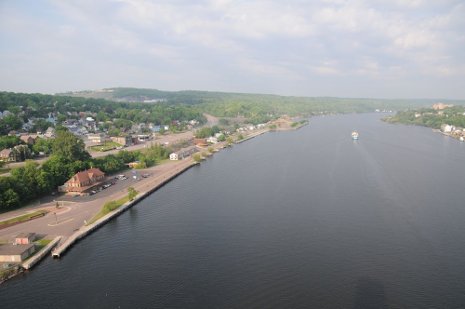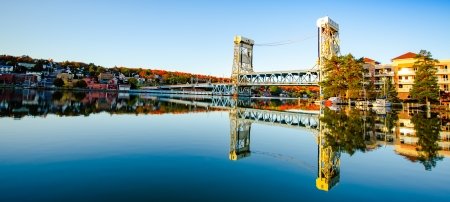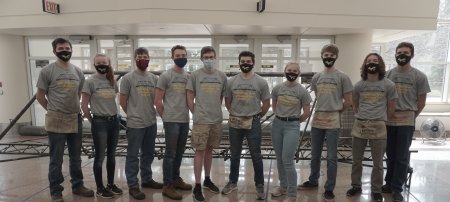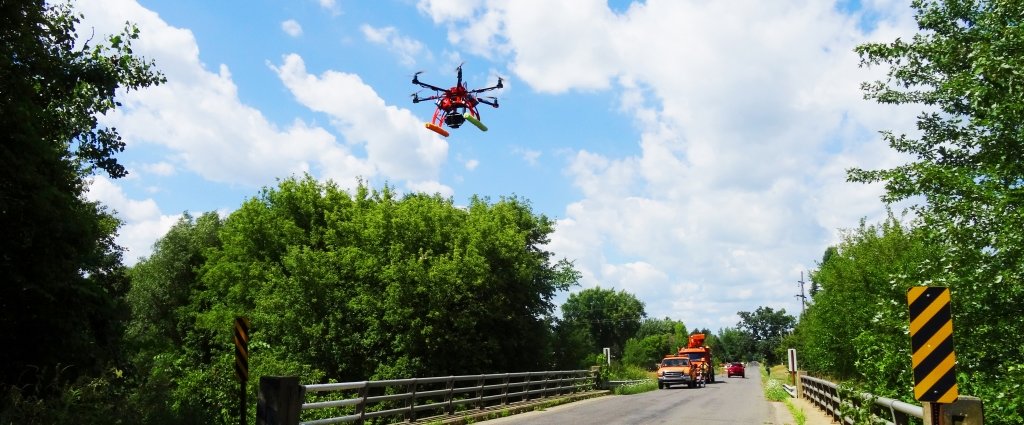A Vibrating View from the Top

The Portage Lake Lift Bridge is a spry half-century old this year, and as summer was heating up (around 90 degrees two days in a row), Clare Rosen, one of our designers; Ryan Schumacher, student photographer; and I ventured to the local icon to catch the view from the top.
Butch Paavola and David Manninen were the operators on duty this day, /with them, we first watched the traffic flow below us from the control room, just above the roadbed.
It was a routine Tuesday morning, awaiting the Ranger III’s biweekly journey from Houghton to Isle Royale.
“Do you hear the road noise in your sleep?” we asked.
“No, you get used to it,” Paavola replied, as the whir of tires over pavement droned around us, accompanied by nearly constant vibrations.
The Ranger hadn’t phoned in yet, so we had time to get to the top.
Manninen, the maintenance operator (“mostly greasing gears”) herded us into the steel contraption, four people in a tiny box: “elevator” is too fancy a word. He clanged the gate closed and began the ascent.
It was slow going, and the gradually changing view from the chamber included the steel girders crisscrossing in front of me, water fading away below and the top of towers sliding closer into view. It was hard to get my bearings, although facing out toward the open water would have been even more disorienting.
As the lift jolted to a stop on top, Manninen opened the gate, unlocked the door and stepped calmly into the south tower. As I followed him, the two-inch crack between the elevator and tower revealed all 210+ feet to the water below. It was almost ten times the height of the top of my house.
Same pigeon problem, though.
“We can’t get rid of them,” Manninen said. Instead of raiding bird feeders, up here the birds gain entry to the towers via some nook or cranny and spend the winter.
Dominating the room on both sides are monstrous wheels called “sheaves” that move the cables that raise and lower the center lift span. Between the sheaves are masses of mechanisms, including gears for braking and an auxiliary engine, just in case. Some of the machinery is painted a bright red, and it all combines to look like a metal shop on steroids.
Throughout the huge room, slants of light shone up through the floor, where metal plates would meet, and there was even a double trap door with handles. I couldn’t imagine stepping through it from here.
There is no view toward the Ranger dock to the east, so we first venture out onto a see-through balcony to the west, hanging on to the railing for the dearest of lives. Then we head onto another balcony that faces north and gives a great view of the bridge, Hancock and Ripley.
The trees have all but leafed out, and the perspective is incredible and overpowering. All these years living here, and I finally saw both towns and the waterway in their entirety: so close, but really more of a feeling of hovering above it all.
The birds-eye view would get better. Schumacher wanted to go all the way up, so Manninen opened the top trap door, and we entered brilliant sunshine and unseasonable warmth on this May day (with some pigeon droppings for good measure).
Just then, the rumbling of the lift span began, and as I knelt (I don’t recall praying), the vibrations jarred the very top of bridge, where I faced Houghton, clutching the railing right behind the flashing red light on the west side.
An interesting observation at this particular moment: there is no railing for more than half of the top of the tower. Our student photographer “braced himself against a big rivet” on the actual slope of the tower roof and shot pictures of the Ranger as it slid toward the bend in the waterway to the west.
After a pause, the rumbling began again, and I spied the vehicles stopped in Houghton, a small backup to the M-26 intersection in one direction, the downtown vehicles disappearing around the Downtowner Lounge to the other.
I had no idea what was happening on the Hancock side. To see that would mean actually turning around after removing one hand from the railing.
The bridge stopped moving under us within the usual six to seven minutes that Paavola had earlier promised, and I knew I had to do it.
I steadied myself, rose to my feet and surveyed the wonders below. The grey-green waterway, the wheeled commerce of the two towns stopped at everyone’s great meeting point, Shopko up the hill, Michigan Tech to the east (I think it was there).
I could put a story behind much of the scenery: the Powerhouse when it was a teen center, the waterfront where I fished and swam, the Houghton Canal Road. The old high school, marina and former Van Orden’s dock area could all tell tales, too.
After taking in at least 270 degrees of the panorama and chatting with Manninen as he ambled around the top like it was his front porch, I gently guided my feet to the opening and descended into the tower room, dropping my pencil before wiping off my work pants.
On the slow ride down the tower, Manninen stopped twice to point out interesting features underneath, with the gate most of the way open and nothing between us and the walleye except the warm breeze. Leaning hard into the wall behind Schumacher, I took his word for it.
I was proud of myself for having done it, and later, as I drove down the hill from Shopko, I could see the red light still flashing up high, in spite of being nearly strangled by my death-grip earlier.
Michigan Technological University is an R1 public research university founded in 1885 in Houghton, and is home to nearly 7,500 students from more than 60 countries around the world. Consistently ranked among the best universities in the country for return on investment, Michigan's flagship technological university offers more than 185 undergraduate and graduate degree programs in science and technology, engineering, computing, forestry, business, health professions, humanities, mathematics, social sciences, and the arts. The rural campus is situated just miles from Lake Superior in Michigan's Upper Peninsula, offering year-round opportunities for outdoor adventure.




Comments